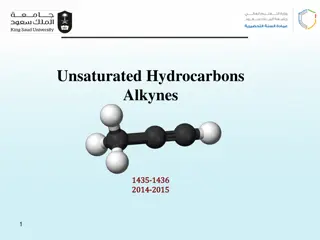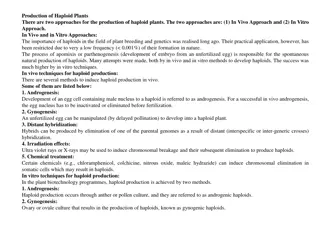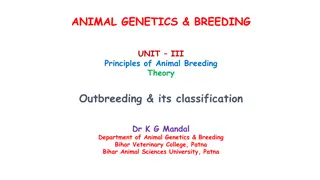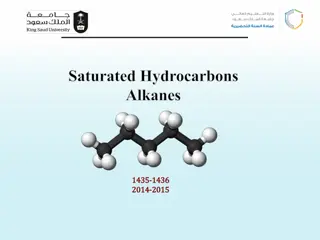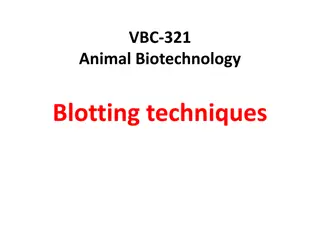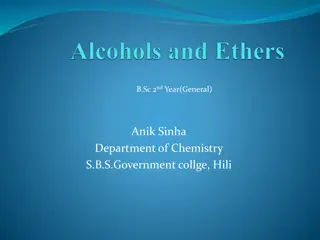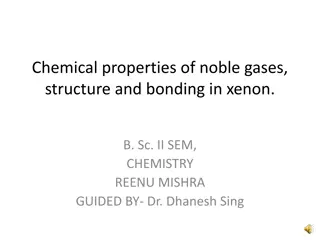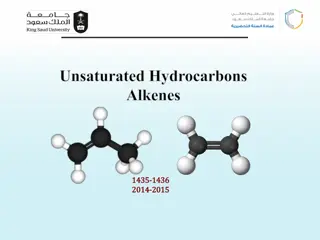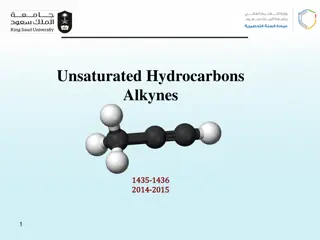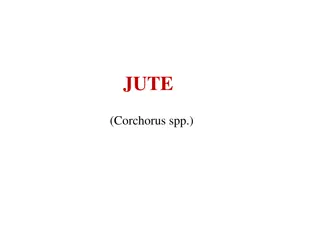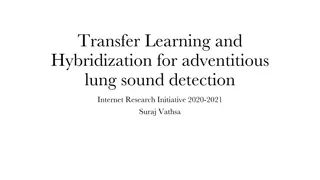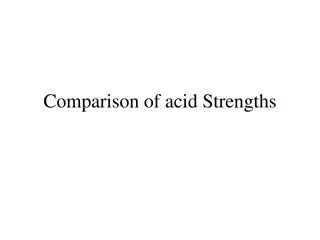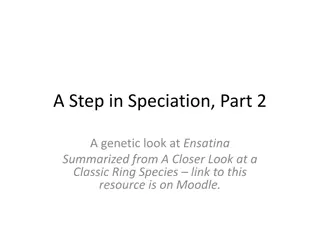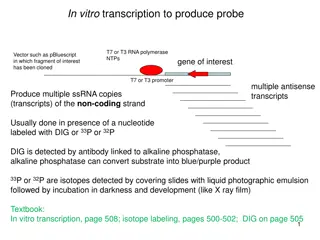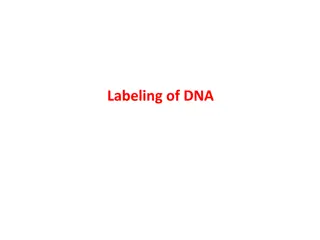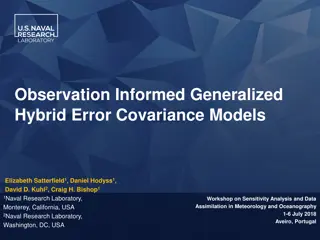Transition Metals Organometallic Compounds Overview
Transition metals bonded with organometallic compounds like metal alkyls, aryls, and hydrides are common in chemistry. Ligands are crucial for stabilizing these complexes, with carbon-based ligands exhibiting diverse binding modes based on the metal's hybridization state. Preparation methods for tra
1 views • 25 slides
Unsaturated Hydrocarbons Alkynes
Chapter three delves into the world of alkynes, focusing on their structure, hybridization, bonding, nomenclature, physical properties, preparation, and reactions. Alkynes are hydrocarbons with at least one triple bond, forming a homologous series with the molecular formula CnH2n-2. The sp hybridiza
0 views • 20 slides
Tight Binding Model Adapted for Graphene from Kittel Chapter 9
This content discusses the tight binding model adapted for graphene based on Kittel Chapter 9, covering topics such as Bloch conditions, hybridization, sublattices, and overlap integrals. It explores the uniqueness of graphene's structure and its impact on coefficients in the calculations.
0 views • 16 slides
Understanding Hybridization in Organic Chemistry
Delve into the complexities of the Lewis octet model and the insights provided by Linus Pauling's localized valence bond hybridization model to explain bond shapes in molecules, reactivity trends, and electron distribution in double and triple bonds. Discover how hybridization transforms atomic orbi
0 views • 22 slides
Production of Haploid Plants: Approaches and Significance
There are two main approaches for haploid plant production - in vivo and in vitro methods. Haploids are important in plant breeding but are rare naturally. Various techniques like androgenesis, gynogenesis, distant hybridization, irradiation, and chemical treatments are used to induce haploid produc
0 views • 4 slides
Understanding Different Methods of Emasculation Techniques in Plant Breeding
Emasculation is a crucial technique in plant breeding to prevent self-pollination and prepare for controlled pollination. Various methods like hand emasculation, hot/cold water, alcohol, and more are used depending on the crop and flower size. Emasculation is key for hybridization in monoecious and
0 views • 12 slides
Principles of Animal Breeding: Outbreeding and Its Classification
Outbreeding involves mating animals less closely related than the average population. It includes outcrossing, crossbreeding, grading up, and species hybridization. Outbreeding increases heterozygosity but decreases homozygosity. Heterosis, or hybrid vigor, shows the superiority of outbreds over par
0 views • 32 slides
Understanding Alkanes: Properties, Structures, and Nomenclature
Alkanes are saturated hydrocarbons containing only single bonds. This chapter covers the classification, general formula, naming conventions, molecular structures, hybridization, and reactions of alkanes. Explore the unique characteristics of alkanes, including their physical properties, cycloalkane
0 views • 44 slides
Understanding Blotting Techniques in Animal Biotechnology
Blotting techniques such as Southern blot, Northern blot, and Western blot are used to transfer DNA, RNA, and proteins onto a carrier for separation following gel electrophoresis. Developed by E.M. Southern, the Southern blot specifically detects DNA fragments in a sample through hybridization. This
0 views • 30 slides
Overview of Alcohols: Classification, Preparation, and Properties
Alcohols are compounds containing hydroxyl groups, classified based on chain type and number of hydroxyl groups. They can be aliphatic or aromatic, monohydric or polyhydric. Classification also includes primary, secondary, and tertiary alcohols based on carbon hybridization with the hydroxyl group.
1 views • 22 slides
Chemical Properties and Bonding in Xenon: A Study of Noble Gases
Noble gases, including xenon, exhibit unique chemical properties due to their stable electron configurations. Xenon forms compounds like xenon difluoride, xenon tetrafluoride, and xenon hexafluoride, showcasing various hybridization states and geometries. These compounds illustrate the reactivity of
0 views • 18 slides
Evolution of Public Sector Audit: Challenges and Solutions
Explore the future of public sector audit in a global context, addressing complexities like accounting scandals, regulatory compliance, and organizational structures. Theoretical frameworks and incremental alternatives are discussed, highlighting the need for improved public value. Interesting devel
0 views • 7 slides
Understanding Covalent Bonds and Molecular Structure in Organic Chemistry
The neutral collection of atoms in molecules held together by covalent bonds is crucial in organic chemistry. Various structures like Lewis and Kekulé help represent bond formations. The concept of hybridization explains how carbon forms tetrahedral bonds in molecules like methane. SP3 hybrid orbit
0 views • 4 slides
Understanding Alkanes: Structure, Properties, and Nomenclature
Explore the world of alkanes, saturated hydrocarbons with single bonds. Learn about their classification, molecular formulas, naming conventions, physical properties, and methods of preparation and reactions. Discover the hybridization of carbon in alkanes and delve into the different classes of car
0 views • 44 slides
Understanding Aldehydes and Ketones in Organic Chemistry
Aldehydes and ketones are compounds that contain carbonyl groups (>C=O). Aldehydes have the CO group linked to either two hydrogen atoms or one hydrogen atom and one alkyl or aryl group, while ketones have the CO group linked to two alkyl or aryl groups. The structure of the carbonyl group is charac
0 views • 26 slides
Understanding Alkenes: Structure, Bonding, and Naming
Alkenes are unsaturated hydrocarbons containing a C=C double bond. This chapter covers topics such as alkene structure, hybridization, naming, isomerization, physical properties, preparation methods, stability rules, and addition reactions. Learn about the sp2 hybridization of orbitals in alkenes, o
0 views • 38 slides
Understanding Biosystematics and Its Significance in Biological Classification
Biosystematics plays a crucial role in refining biological classification by focusing on biological criteria to define relationships within closely related species. It helps delineate biotic communities, recognize different biosystematic categories, and understand evolutionary patterns. Through the
0 views • 15 slides
Understanding Alkynes in Organic Chemistry
Alkynes are unsaturated hydrocarbons with at least one triple bond, following a molecular formula of CnH2n-2. This group of compounds is discussed in Chapter three, covering topics like structure, hybridization, common naming, physical properties, preparation, and reactions. The sp hybridization of
1 views • 20 slides
Understanding DNA and RNA as Genetic Material
Genetic material plays a crucial role in the transmission of traits from one generation to the next. This article explores the significance of DNA and RNA as genetic material, highlighting key experiments and discoveries that demonstrate DNA's role in carrying hereditary information. From Mendel's h
0 views • 32 slides
Understanding Social Enterprise Cross-Sector Theory by Dr. David Bozward
Explore the origins, definitions, and key theories of social enterprise, including the hybridization concept, Leadbeater's model, and more market-focused approaches. Learn about the impact of social enterprises on society and the unique role they play in combining economic principles with social goa
0 views • 23 slides
The Significance of Jute Cultivation in India's Economy
Jute, a vital commercial fibre crop in India, holds a prominent place in the economy of states like West Bengal, Assam, Bihar, Orissa, and Eastern Uttar Pradesh. It serves as a crucial source of foreign currency earnings and provides employment to millions of farmers and workers. Originating from th
0 views • 28 slides
Non-Isotopic Labeling for Molecular Detection
The use of non-radioactive probes in molecular detection involves synthetic DNA or RNA molecules with specific target sequences and reporter groups detectable via fluorescence spectroscopy. Direct and indirect labeling methods utilize fluorescent dyes or enzymes conjugated to modified nucleotides, a
0 views • 20 slides
Understanding Nucleic Acid Blotting: Southern Blotting Techniques
Nucleic acid blotting techniques, including Southern blotting, are crucial for transferring DNA, RNA, and proteins for analysis. Southern blotting, developed by Edwin Mellor Southern, is used to probe specific DNA sequences, aiding in applications such as gene isolation, DNA fingerprinting, and dise
0 views • 11 slides
Advanced Artificial Intelligence for Adventitious Lung Sound Detection
This research initiative by Suraj Vathsa focuses on using transfer learning and hybridization techniques to detect adventitious lung sounds such as wheezes and crackles from patient lung sound recordings. By developing an AI system that combines deep learning models and generative modeling for data
0 views • 6 slides
Factors Affecting Acid Strength: Atoms, Size, Hybridization, and Electronegativity
The strength of acids is influenced by various factors such as the atom on which the negative charge of the acid's conjugate base rests, atom size, hybridization, and electronegativity. The stability of negative charges on atoms, atom size allowing charge delocalization, preferred orbital types for
0 views • 23 slides
Genetic Insights into Ensatina: A Study of Ring Species Speciation
Genetic analysis of Ensatina populations in California by Tom Devitt and team revealed complex groupings challenging previous taxonomic classifications. Hybridization patterns and hypotheses are explored, shedding light on post-mating isolation mechanisms. The study utilizes mitochondrial DNA sequen
0 views • 10 slides
Understanding Electric and Hybrid Vehicles: Hybridization and Interdisciplinary Aspects
Electric and hybrid vehicles (HEVs) feature different hybridization ratios based on the power rating of their electric motors. Concepts like full hybrid, mild hybrid, and micro hybrid define the extent of electric motor usage for driving. HEVs involve a mix of electric machines, power electronics, b
0 views • 50 slides
Understanding In Vitro Transcription and Probe Production
In vitro transcription involves utilizing T7 or T3 RNA polymerase to produce multiple single-stranded RNA copies of a gene of interest. These transcripts can be used to create probes for detecting specific RNA sequences. The process often involves labeling with DIG or radioisotopes like 33P or 32P,
0 views • 8 slides
Understanding Nucleic Acid Labeling and Detection in Molecular Biology
Nucleic acid labeling and detection play crucial roles in molecular biology, where hybridization helps identify complementary DNA or RNA sequences. Techniques like using labeled probes are essential for precise detection in complex nucleic acid mixtures. Understanding radioactive activity units and
0 views • 22 slides
Sympatric Speciation: Evolution Without Geographic Isolation
Sympatric speciation involves the evolution of reproductive isolation without geographical barriers, leading to the splitting of an ancestral species into reproductively isolated groups within the same area. Possible reasons for reproductive isolation include disruptive selection, competition for re
0 views • 9 slides
Investigation of Observation-Informed Generalized Hybrid Error Covariance Models
In the field of meteorology and oceanography, the study focuses on the development of hybrid error covariance models that combine flow-dependent and climatologically-based estimates for improved data assimilation. The research aims to determine optimal hybridization parameters through innovative met
0 views • 14 slides
Understanding DNA Linkers, Adapters, and Selection of Recombinants
DNA linkers and adapters play crucial roles in genetic engineering by facilitating ligation of DNA molecules and selecting appropriate restriction enzymes. Furthermore, DNA hybridization allows for the assessment of evolutionary relatedness based on base pair sequences. This process involves the for
0 views • 5 slides

